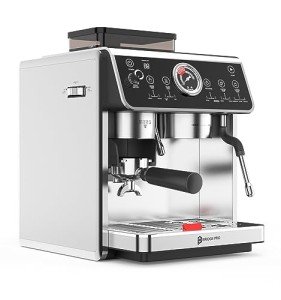The Art of Italian Espresso Machines: A Brewed Tradition
Italian espresso machines are not simply home appliances; they are an essential part of Italy's abundant coffee culture, representing a mix of artistry, engineering, and design. Coffee fanatics worldwide acknowledge the importance of high-quality espresso, a staple of Italian life and food. This article checks out the history, mechanics, types, and factors to consider when buying an Italian espresso machine, showing the depth of this beloved beverage and its developing techniques.
History of Espresso Machines
The espresso machine's advancement go back to the early 20th century in Italy, where coffee was not merely a beverage but a necessary social ritual. The initial attempts to brew espresso started with simple, stove-top designs, slowly progressing into complicated machines that might reproduce the perfect brew.
- 1901-- The First Espresso Machine: The very first steam-powered espresso machine, understood as the "Ideale," was established by Luigi Bezzera. This equipment marked a turning point in espresso developing.
- 1938-- The Lever Machine: The introduction of the lever machine made it simpler to control the pressure used in espresso extraction, enhancing taste consistency.
- 1947-- The Automatic Machine: Reaching more consumers, Gaggia launched the first automatic espresso machine, more promoting espresso bars.
- 2007-- The Digital Age: Technological developments caused the birth of fully programmable machines, enabling users to tailor their developing settings to attain an individualized coffee experience.
Key Features of Italian Espresso Machines
Italian espresso machines embody precision, craftsmanship, and innovation. Here are some essential components that highlight their significance:
| Feature | Description |
|---|---|
| Boiler Type | Determines how heat is produced and preserved. the full report include single boiler, dual boiler, and heat exchanger. |
| Group Heads | Where the coffee is brewed; commercial machines typically have several group heads for performance. |
| Pressure Control | Crucial for accomplishing the perfect espresso; most machines run at 9 bars of pressure. |
| Frothing Capabilities | The steam wand permits milk frothing, important for drinks like cappuccino and latte. |
| Develop Quality | The materials used (stainless-steel, brass, and so on) impact durability and heat retention. |
Types of Italian Espresso Machines
Selecting the best machine depends upon user choices, budget, and planned use. Below are the main kinds of Italian espresso machines:
Manual Espresso Machines
- Pros: Offer complete control over the developing process, permitting a customized touch.
- Cons: Require skill and practice, can be labor-intensive.
Semi-Automatic Machines
- Pros: Provide a balance in between automatic and manual processes; users manage water circulation.
- Cons: Can have a steeper learning curve than totally automatic machines.
Totally Automatic Machines
- Pros: Simplify the brewing process with push-button operations; suitable for beginners.
- Cons: May compromise a few of the subtleties of manual developing.
Super-Automatic Machines
- Pros: Grind, tamp, brew, and froth immediately; practical for hectic way of lives.
- Cons: Less control over the developing variables, capacity for a less authentic espresso experience.
Purchasing Guide: Factors to Consider
Picking the perfect Italian espresso machine can be challenging, however thinking about the following factors can simplify the decision-making procedure:
- Budget: Italian espresso machines vary from affordable to high-end designs, so set a budget upfront.
- Use Frequency: Evaluate how typically you will use the machine; day-to-day users may desire a more resilient alternative.
- Area: Measure your kitchen area or counter space; some machines can be large and require enough clearance.
- Maintenance: Consider ease of cleaning; machines with removable parts or integrated cleansing functions might lower upkeep.
- User Skill Level: Beginners might prefer completely or semi-automatic machines, while skilled baristas can deal with manual machines.
- Brand Reputation: Research brands known for quality, such as Breville, Gaggia, and La Marzocco.
Popular Italian Espresso Machine Brands
Italian workmanship is renowned for producing some of the very best espresso machines worldwide. Here are top brand names worth thinking about:
- Gaggia: Known for its home espresso machines and price.
- La Marzocco: A premium brand name known for its commercial-grade machines and innovative innovation.
- Rancilio: Renowned for its durable build and professional-quality machines appropriate for home and commercial use.
- Sage/Breville: Offers advanced functions and easy to use designs, ideal for both novices and enthusiasts.
FAQs
What is the distinction between espresso and regular coffee?
Espresso is a concentrated coffee brewed by requiring hot water through finely-ground coffee under pressure. It has a thicker consistency, richer taste, and higher caffeine concentration than regular coffee.
Can I make milk-based beverages with an espresso machine?
Yes, numerous Italian espresso machines include a steam wand to froth milk for beverages like cappuccinos, lattes, and macchiatos.
How typically should I clean my espresso machine?
Regular maintenance is important. Normally, an extensive cleaning is suggested every couple of weeks, while descaling ought to be done every 1 to 3 months, depending upon water hardness.
What is the ideal pressure for developing espresso?
The perfect pressure for developing espresso is around 9 bars. This pressure guarantees the ideal extraction of tastes from the coffee grounds.
Are more costly machines worth the financial investment?
Higher-end machines typically make use of much better materials and technology, providing enhanced resilience and more consistent outcomes. For serious coffee fans, purchasing a good machine can elevate the espresso experience significantly.
Italian espresso machines are much more than mere brewing devices; they are an event of a cultural custom that has actually affected coffee consumption worldwide. With numerous designs available to fit any user's needs-- ranging from novices to seasoned baristas-- there is an Italian espresso machine completely matched for everyone. As you embark on your espresso journey, understanding the history, mechanics, and choices will enhance your experience and gratitude for this time-honored drink. Whether you look for to recreate a café atmosphere in the house or improve your brewing method, these machines are capable of delivering extraordinary cups of espresso adorned with the rich history of Italian coffee culture.

